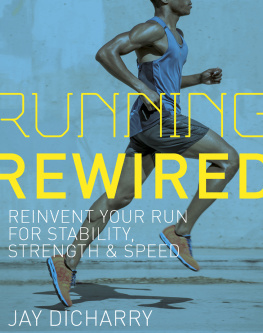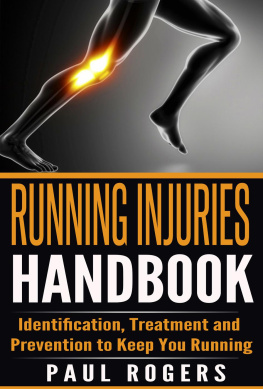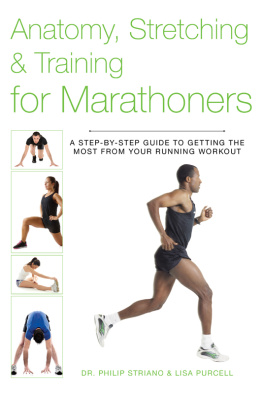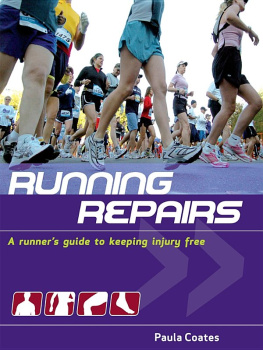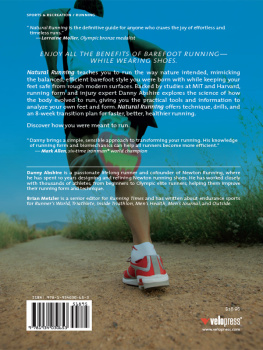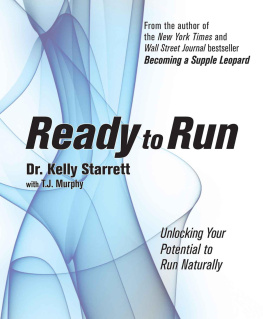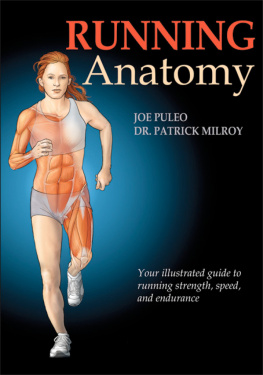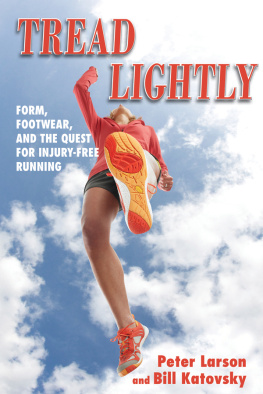Anatomy for
Runners

Unlocking Your Athletic Potential for
Health, Speed, and Injury Prevention
JAY DICHARRY, MPT, SCS

Skyhorse Publishing
Copyright 2012 by Jay Dicharry
Photos Copyright 2012 by Joel Wolpert unless otherwise noted
All Rights Reserved. No part of this book may be reproduced in any manner without the express written consent of the publisher, except in the case of brief excerpts in critical reviews or articles. All inquiries should be addressed to Skyhorse Publishing, 307 West 36th Street, 11th Floor, New York, NY 10018.
Skyhorse Publishing books may be purchased in bulk at special discounts for sales promotion, corporate gifts, fund-raising, or educational purposes. Special editions can also be created to specifications. For details, contact the Special Sales Department, Skyhorse Publishing, 307 West 36th Street, 11th Floor, New York, NY 10018 or info@skyhorsepublishing.com.
Skyhorse and Skyhorse Publishing are registered trademarks of Skyhorse Publishing, Inc., a Delaware corporation.
Visit our website at www.skyhorsepublishing.com.
10 9 8 7 6 5 4 3 2 1
Library of Congress Cataloging-in-Publication Data is available on file.
ISBN: 978-1-62087-159-1
Printed in China
To my mom and dad for the lessons
To my wife for the love
To my kids for the future
To my friends for support
And to Ferris Bueller for daily inspiration
ThanksJay
Contents

Preface

A long time ago, there was a boy who swam. He trained about 15 to 18 hours a week in the water, counting pool tiles and singing in his head to pass the time. The high school cross-country coach was looking to recruit individuals for the team. The boy was recruited (OKforced, it was private school) to run. This little lad wasnt really into the idea, but found he loved it. Instead of counting pool tiles, he could actually have a conversation while training. He could look up at the sky, feel the wind, and smell the fresh exhaust coming out of the tailpipe of each passing car (this was the city). Due to his swimming fitness, he made gains quickly. However, injuries were his biggest nemesis. Hed get hurt and need to take time off. After recovery he ran again, only to find the same pains. He went to expert orthopedists. These doctors told him that his parts were finethey said to take some time off or (worse) stop running.
This answer didnt really sit well with him. His friends and teammates all ran much more than he did, and they werent getting hurt. He was spending so many hours training his heart and lungs in the pool that it was practically a part-time job. Each and every day, he did tons of drills, repeats, and lifted weights to help him become a better swimmer. But in cross-country practice, all he had to do was run... and he kept getting hurt. And all the while the docs said his parts were fine and maybe they werent working right together.
If you guessed that this boy was me, youd be right. As long as we are coming clean here, I should let you know that the reason I entered health care was not to help others like everyone writes on their application essay. I wanted to get into health care because I got sick and tired of getting generic information. Your X-ray is clean. Rest. Take time off. OKI did all that and then tried to resume running, and it would come right back within a few weeks. My vicious cycle of running, injury, rest continued throughout my entire high school career. By the time I got to college, I was so sick of it, I stopped running for years. I couldnt find anyone who could look past my symptoms and get to the root of my problem.
A lot of you have been in my shoes (excuse the pun). Or maybe youve seen your coach or treat runners who always seem to fall into the same injury cycle that they just cant break. So this work is a summary of what Ive learned over my personal, educational, and professional career. I am going to come at all of this from a different angle than most of what youve heard in the past because the realm I operate in combines the very different fields of clinical care, biomechanical analysis, and coaching.
The experts in these fields all have very different mind-sets. Clinicians use their brains to cluster your signs and symptoms to arrive at a diagnosis. In patient care, its rare that things are 100 percent the same in 100 percent of the people, 100 percent of the time. Clinicians look for a variety of things to line up. The advantage to this approach is that it guides your intervention to solve the current problem and makes you feel better at the present. This focus on symptoms masks the pain and makes it challenging to identify the root of the problem. Sometimes the cause is rather obvious, such as a sharp transition in training load, but often, there is a critical imbalance that shifts the repetitive overload on the bodys tissues. If the body cant adapt, it breaks. Wouldnt identifying the imbalance help?
Scientists, namely biomechanists, are much more objective in nature. They are trying to find the answer. Their contribution to the theory and foundation of running science has been, and continues to be, overwhelmingly positive. They ask questions, find answers, and come up with yet more questions. While this is intellectually stimulating, biomechainsts dont treat the individual patients and have no idea how to actually help you. People are by nature, variable. While its tough to find the exact reasons why groups of people have certain injuries, or become efficient, or dont, its even tougher to identify the reasons impacting each and every person individually. Getting the answer is very hard!
Coaches are resultsfocused. You, Mom, Dad, the team, the sponsors all want the big W. Good coaches listen first. Guys and gals, Ill let you in on a little secret: There is no magical workout. The art of coaching is all about figuring out how your athletes will respond to your training plan and tailoring the timing of the program to their needs. Coaches are steadfast, honorable folks that we can look up to because they really do have our best interests at heart. They are trained to listen to your body and tailor the workout dose and timing to you. But when we start asking why a runner got a stress fracture or what shoes they should be in or how to return a runner following their injury, we realize that these folks typically lack the knowledge and resources to answer the questions that face them. Its outside of their job description.
Id like to share a quote from a physician named Tom Novacheck: Much can be gained if the biomechanist and pathophysiologist come out of the laboratory, the clinician pulls himself out of the clinic, and they all meet on the track. All parties bring critical information to get to the root of the issue. If you approach running by combining the theory of movement, a thorough understanding of the individuals strengths and weaknesses, and training loads, you begin to find answers. This is what Ive tried to do in my career as a clinician, coach, and researcher, and what Ive tried to do for you in this book.
While we (as a scientific and clinical community) dont have all the answers to every risk factor of every injury, we do know a lot. The media is encouraged to focus on the latest trends and


